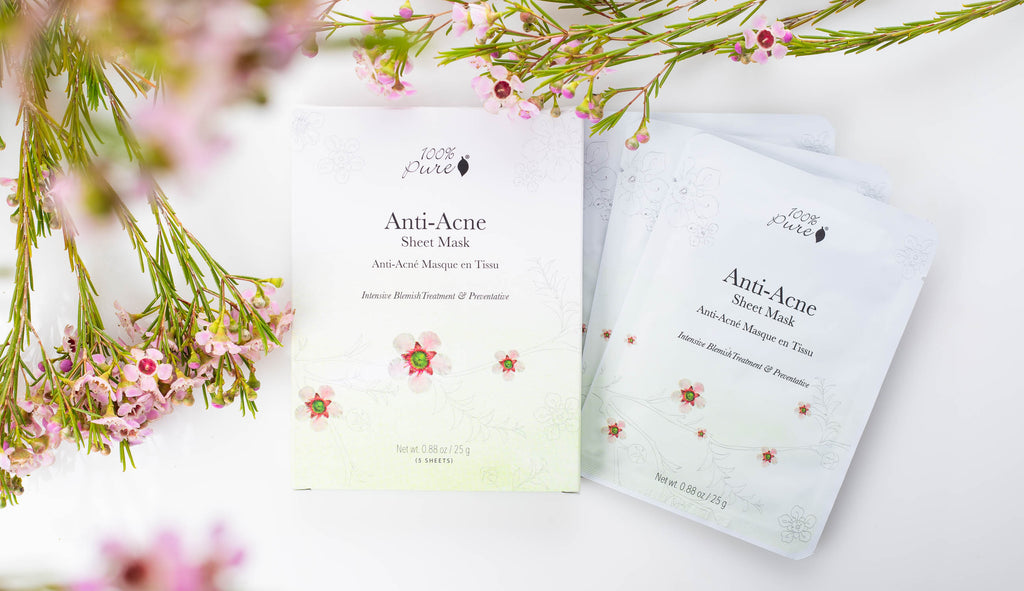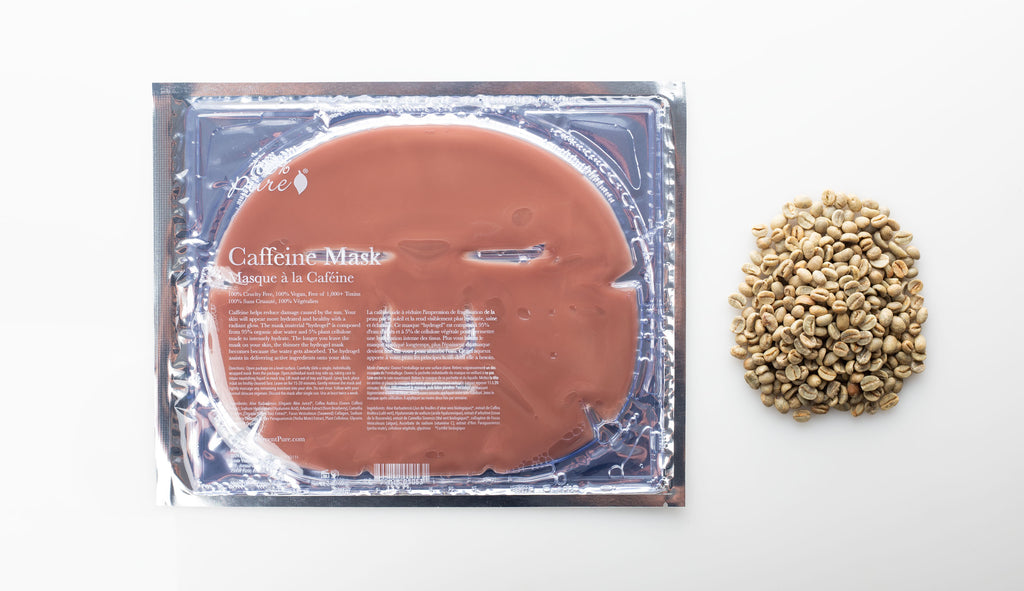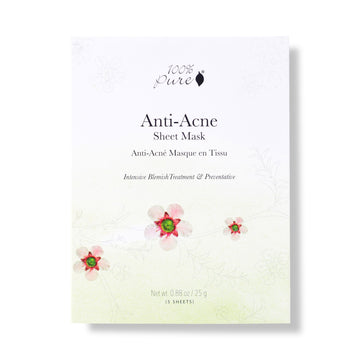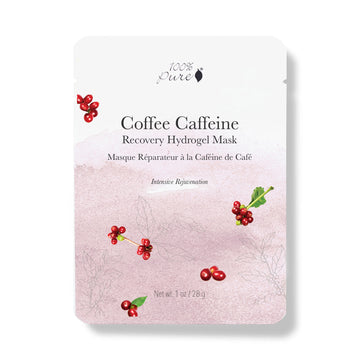How to shop for acne masks that won’t strip your skin, plus DIY acne mask recipes and natural alternatives!
Written by: 100% PURE®
Ever been seduced by an all-powerful, acne-blasting product? One that claims to “zap” the blemish into oblivion? When you’ve got acne - whether it be the occasional ‘honker’ to the dreaded daily blemishes blanketed over your skin - it’s easy to get desperate, and try anything that claims to work.
With desperation can come some risks to your skin, especially if you’re using a product all over your face. Spot treatments only target one small area, while products like acne masks blanket your whole face in blemish-fighting ingredients. What we’ve learned is if you’re going the mask route, you should NOT use something harsh (which is normally what we’d reach for to eradicate those pesky pimples). When it comes to acne masks, we think it’s time to crack the case wide open!
Follow along as we call out no-no acne mask ingredients, praise skin-loving (and blemish beating) DIY acne mask recipes, and spotlight some of our favorite natural masks that get the job done, minus the risks to your skin.
Here’s the deal with masks: unlike cleansers and toners, they are designed to stay on your face for a prolonged period of time. Whether it’s a cream mask, sheet mask, or rubber mask, it’s staying on for at least 10-15 minutes. This means that whatever you’re putting on your face has a good, long while to soak into your dermis. Here are a few common acne mask ingredients you should use sparingly:
Cetyl Alcohol
Cetyl Alcohol is used as an emulsifier or emollient in skin care and body care, and is classified as a fatty alcohol. While both the FDA and many skin care brands have deemed cetyl alcohol safe for use, there are many dermatologists who warn against their regular use. They claim that this ingredient can actually further irritate sensitive or inflamed skin, and even damage lipid barrier function.
Parabens
Sadly, even acne masks are made with parabens. Added as fragrances and/or preservatives in many cream mask formulas, parabens are primed to sit on your skin for minutes, and will be absorbed by your body. We looked up some of the most popular acne mask formulas and found parabens galore: Methylparaben, Ethylparaben, Butylparaben, Propylparaben, and Isobutylparaben. These ingredients don’t do a single thing for treating acne, and yet you’ll find them in lots of acne products. Steer clear to avoid risk for irritation, organ toxicity, endocrine disruption, and even cancer.
Silicones
These heavy, synthetic emollients spell disaster when it comes to clogging pores. Silicone prevents skin from breathing, and can also trap sebum (oil) inside the pore, leading to clogging and acne-causing buildup.
Polyethylene Glycol
Also known as PEGs, these ingredients are used as thickeners and stabilizers in skin care formulas. Much like silicones, they are very thick, sticky, and heavy -- meaning they’ll also trap unnecessary buildup in your pores.
Benzoyl Peroxide
A popular ingredient in over-the-counter acne treatments, benzoyl peroxide should only be used for spot treatments. Spreading this potent chemical mixture across your already inflamed, irritated skin will just beg for more irritation and even rashes.

While we may have taken the wind out of your sails in “no-no” mask ingredients section, we promise we can redeem ourselves!
Our Anti Acne Sheet Mask is a wonder for gentle, daily use against acne. Ingredients like aloe and hyaluronic acid hydrate dry or irritated skin. Antibacterial herbs like parsley and rosemary also help by killing acne-causing bacteria while you wear the mask. Unlike more harsh mask treatments that seem to sting and burn, this mask’s hydration and natural cast of characters will soothe, nourish, and improve your skin with every use.
Our Caffeine Mask is a hydrogel dream for soaking pure hydration into your skin. What makes caffeine so great for acne, you ask? The stimulating nature of caffeine is a natural vasoconstrictor, meaning it constricts blood vessels when consumed internally. When applied topically, similar results can be achieved in skin. It temporarily tightens your skin to calm redness and inflammation: two very common side effects of acne.
These at-home acne remedies are easy to whip up, and your skin will thank you for it. First identify your DIY acne mask allies: egg whites, honey, apple cider vinegar, aloe vera, baking soda, kaolin clay, tomato juice, kiwi, papaya, oats, and coconut milk. Whew! Who knew that all of these pantry ingredients could help you banish blemishes? Next, deeply cleanse your skin and encourage pores to open with steam. Clean, open pores will better receive soothing anti-acne nutrients from your mask.
Calming Acne Mask
Aloe Vera + Parsley + Coconut Water
Perhaps the most necessary of acne masks, since you’ll need to calm inflamed acne before you can treat it. Aloe vera is world-famous for soothing even the most angry skin, which is why you’ll recognize it as a soothing sunburn treatment. Parsley is an antibacterial, anti-inflammatory ingredient which contains naturally high sulfur content -- an anti-acne ingredient you’ll see gaining popularity in the beauty world. Adding anti-microbial, anti-inflammatory coconut water will seal the deal in this skin-soothing concoction.
-
Harvest 1 bunch of parsley, by removing leaves from their stems, then measure out 2 cup into a food processor. Pulse until you get a superfine, spreadable texture.
-
Using a small whisk, miix 1 tbsp pure aloe vera gel, 1 tbsp coconut water, and 2 cups parsley in a small bowl.
-
With clean fingers, apply mixture to face, barely rubbing into skin before leaving to set for 20-25 minutes. Rinse with lukewarm water.
Oil-Banishing Acne Mask
Baking Soda + Kaolin Clay + Tomato Juice
This one is a summertime savior for acne-prone, oily skin types. If you suffer from breakouts due to excess oil, clogged pores, or simply can’t get your makeup to set because of oily skin, try this DIY mask recipe! Baking soda and kaolin clay absorb excess oil, in addition to baking soda’s antiseptic and anti-inflammatory properties (to manage any current blemishes). The acid content of tomato juice makes for an incredibly potent pore tightener, to reduce overproduction of oil. Tomato is also a fantastic oil-absorber, as its acid content dries up and cuts through sticky, excess sebum sitting on the skin.
-
Combine 1 tbsp baking soda, 1 tbsp kaolin clay, and 1.5 tbsp tomato juice in a small bowl.
-
Mix thoroughly with a whisk, until all lumps are blended out.
-
Apply paste mixture onto skin, allowing to sit for 15-20 minutes before massaging off with a lukewarm water.
Hydrating Acne Mask
Oatmeal + Honey + Coconut Milk
These ingredients are tried-and-true hydrators, especially when combined. Oatmeal plumps up when combined with liquids -- and can even absorb excess oil. Honey hydrates the skin while killing acne-causing bacteria with its antibacterial, antimicrobial properties. Coconut milk is also a powerful antimicrobial, and moisturizer. Enzymes in coconut can also help to clear pores and gently exfoliate the skin for a brighter, more even complexion.
-
Measure ⅓ cup oats and pour into food processor. Pulse into a lightly textured powder.
-
Scoop ½ tbsp honey into a small, clean bowl.
-
Pour 1 tbsp coconut milk into bowl, and add oats. Stir with a fork or whisk until a creamy paste has formed.
-
Using a tongue depressor, apply mask to face. Allow to set for 15-20, then remove by rinsing with warm water. Follow with a toner to remove any leftover stickiness.
- Tags: October-2018, Skin Care, Susies Lab
We carefully hand-select products based on strict purity standards, and only recommend products we feel meet this criteria. 100% PURE™ may earn a small commission for products purchased through affiliate links.
The information in this article is for educational use, and not intended to substitute professional medical advice, diagnosis, or treatment and should not be used as such.



